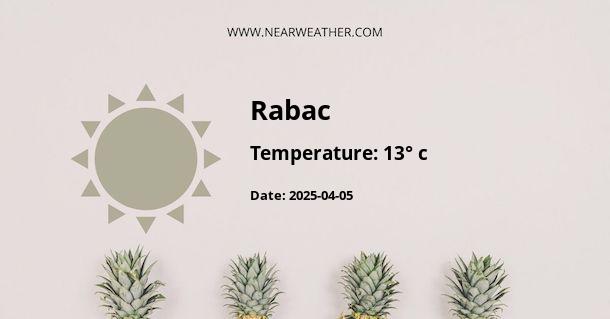Understanding the Climate and Weather of Rabac, Croatia
In the heart of Croatia's Istrian peninsula lies the small, picturesque seaside town of Rabac. Known for its stunning pebble beaches and clear turquoise waters, Rabac has become an acclaimed tourist destination, attracting visitors from around the world.
Geographical Influence on Rabac's Climate
The climate of Rabac is influenced by its location along the Adriatic coast. Predominantly Mediterranean, Rabac experiences mild, humid winters and hot, dry summers. The presence of the Učka mountain range to the north offers some protection from cold northern winds, contributing to the area's temperate weather patterns.
Temperature Patterns in Rabac
| Month | Average High (°C) | Average Low (°C) |
|---|---|---|
| January | 9 | 3 |
| February | 10 | 3 |
| March | 12 | 5 |
| April | 16 | 8 |
| May | 21 | 12 |
| June | 24 | 16 |
| July | 27 | 18 |
| August | 27 | 18 |
| September | 23 | 15 |
| October | 18 | 11 |
| November | 13 | 7 |
| December | 10 | 4 |
The table above illustrates the average high and low temperatures characteristic of each month in Rabac, with July and August typically being the warmest months and January and February the coldest.
Precipitation and Humidity in Rabac
Rabac experiences a significant amount of rainfall throughout the year, with the heaviest precipitation occurring in late autumn and early winter. The average annual rainfall is approximately 1400 mm. The combination of the warm Adriatic Sea and the prevailing winds often results in high humidity levels, particularly during the summer months.
Wind Patterns and Their Effects
- Bora: A cold and dry northeasterly wind, the Bora can affect Rabac, especially in winter and early spring, bringing clear skies but also significantly cooler temperatures.
- Scirocco (or Jugo): This southeasterly wind brings moisture from the sea, often causing rainy and stormy weather. It is most common in autumn and spring.
- Mistral: A pleasant northerly wind that typically arises after midday in the summer, the Mistral provides a cooling effect on hot days, making it a welcome feature of Rabac's summer weather.
Weather Influences for Travel Planning
When considering a visit to Rabac, it is important to take into account the time of year and associated weather conditions. The peak tourist season runs from June through August, coinciding with the warm and dry summer climate that is ideal for beach activities and exploration. Nonetheless, the 'shoulder seasons' of late spring (April and May) and early autumn (September and October) also offer comfortable temperatures and fewer crowds, providing a more relaxed experience of the region’s beauty.
Sunlight and Day Length Throughout the Year
Given Rabac's northerly Mediterranean location, daylight hours vary significantly throughout the year. Visitors in summer can enjoy approximately 15 hours of daylight, while in winter, daylight can be as brief as 9 hours. This significant difference impacts not only the climate but also day-to-day activities and mood.
Impact of Climate Change on Rabac's Weather Patterns
As a coastal town, Rabac and the broader Istrian region are not immune to the ongoing challenges posed by climate change. Rising sea levels, changing precipitation patterns, and the increase in the frequency and intensity of extreme weather events are concerns for local residents and policymakers. Scientific research suggests that the Mediterranean climate, known for its predictability, is now experiencing more variability, which could have long-term implications for tourism, agriculture, and ecosystem health in Rabac.
Seasonal Activities and Weather Considerations
Rabac offers a variety of seasonal activities that are influenced by its weather patterns:
- Summer (June to August): Ideal for swimming, sailing, snorkeling, and other water-based recreation. The Mistral wind is particularly favored by sailors and windsurfers.
- Autumn (September to November): With the sea still warm from the summer sun, early autumn can be perfect for water activities, while the hinterlands offer excellent conditions for hiking and cycling.
- Winter (December to February): The cooler temperatures and increased precipitation make it a perfect time for visiting cultural landmarks, enjoying local cuisine and experiencing seasonal festivities.
- Spring (March to May): This season is a great time for exploring the natural beauty of the region, with wildflowers in bloom and the weather being mild enough for outdoor adventures.
Rabac's delightful Mediterranean climate, coupled with its captivating natural scenery, makes the town an enchanting destination for tourists year-round. However, understanding the nuanced weather patterns and seasonal characteristics can enhance the experience, providing visitors the opportunity to align their activities with the most favorable conditions.
A - Rabac's Latitude is 45.079441 & Longitude is 14.157500.
A - Weather in Rabac is 13° today.
A - Climate Conditions in Rabac shows clear sky today.
A - Humidity in Rabac is 73% today.
A - Wind speed in Rabac is 15.55 km/h, flowing at 354° wind direction. today.
